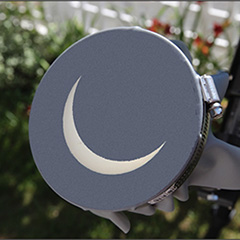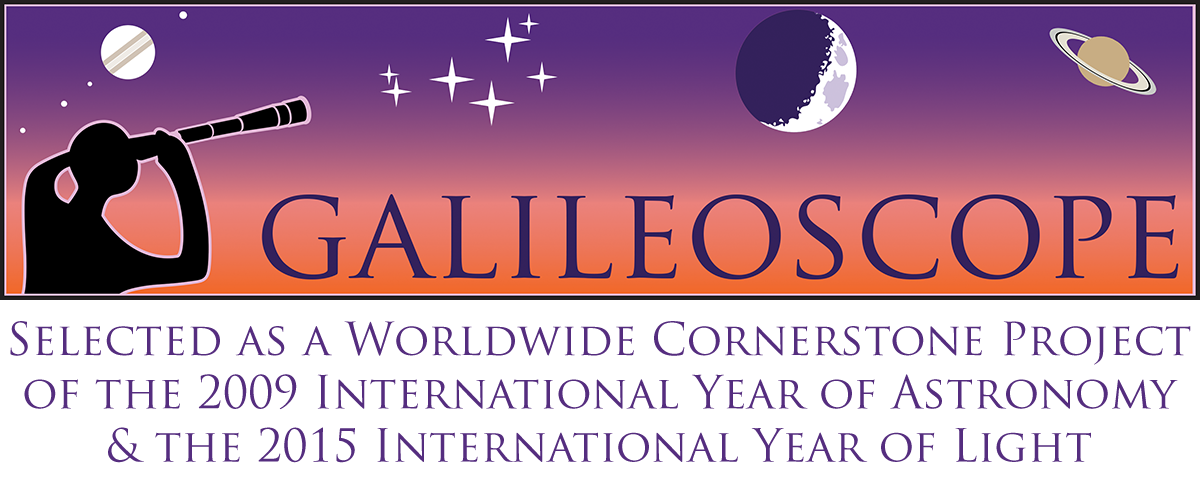With a special-purpose solar filter or a do-it-yourself Sun Funnel, you can safely observe our daytime star with the Galileoscope!
With a special-purpose solar filter or a do-it-yourself Sun Funnel, you can safely observe solar eclipses — when the Moon partially or totally blocks the Sun’s bright face — with the Galileoscope. Over the next decade every continent on Earth will be favored with some type of solar eclipse (see EclipseWise.com). These fascinating events, in which the Sun, Moon, and observer align, excite people (especially young people) about science and connect them personally to the cosmos.

Left: The partially eclipsed Sun, photographed through a safe solar filter. Right: The totally eclipsed Sun, which is safe to view directly. All photos on this page are by Rick Fienberg.

Even without an eclipse, the Sun is a wonderful telescopic target, often displaying splotchy sunspots and other signs of magnetic activity. But our mothers told us never to look sunward, and commercial telescopes — including the Galileoscope — come with stickers warning never to point at the Sun (the Galileoscope sticker is shown at right). So what are we to do?
It turns out that there are several ways to observe the Sun safely with a telescope. Two of them work well with the Galileoscope. One is to use a special-purpose filter that fits over the front opening of the Galileoscope to block all but a minuscule fraction of the Sun’s light (including solar ultraviolet and infrared radiation) and create a safe, comfortably bright image in the eyepiece. If you already own a Galileoscope, you can buy a single, inexpensive 70-mm-diameter solar filter for it from Rainbow Symphony, one of the best-known manufacturers of safe solar filters. If you’re an educator, you can pre-order heavily discounted 10-packs of Galileoscopes with custom-made solar filters and other accessories for delivery in Summer 2023, ahead of the annular (“ring of fire”) solar eclipse that sweeps across the Americas in October 2023 and the total solar eclipse that does the same in April 2024.

A Galileoscope equipped with a Rainbow Symphony black-polymer solar filter and mounted on a photo tripod.

An image of the Sun’s partially eclipsed disk projected from a small telescope onto the screen of a Sun Funnel.
A cardboard solar shield on the front of your Galileoscope will make it easier to aim at the Sun and more comfortable to observe the Sun, since your head will be in shade. For instructions on how to make and use a solar shield (as well as an alternative to a tripod), see our companion article, “Make a Box Mount & Solar Shield.”
Another way to observe the Sun safely is perfect for groups: projecting an image of the Sun onto a card or screen. The best way to use the Galileoscope this way is rear-screen projection, first popularized (to the best of our knowledge) by Bruce Hegerberg in his aptly named Sun Gun. With this device and others like it, a clear image of the Sun is visible on a screen, and the intense sunlight is fully safely contained within the projector.
Our favorite rear-screen solar-projection device is the Sun Funnel, which Gene Zajac and Chuck Bueter adapted from an earlier design and first presented at the 2003 Great Lakes Planetarium Association Annual Conference. The device uses inexpensive, readily available materials and takes just a few minutes to build with very simple tools.

Top and side views of a completed do-it-yourself Sun Funnel.
A thoroughly illustrated guide to building a Sun Funnel, including a list of parts and where to get them, is available as a 2.2-megabyte PDF, which you may download here for free:
The PDF includes tips for aiming a telescope at the Sun and, for educators and others who might be interested, goes through the math behind solar projection.
The Sun Funnel & the Galileoscope
The Galileoscope is an ideal telescope to use with the Sun Funnel. With more than a quarter million of these inexpensive, high-quality telescopes in use around the world, it would be a shame not to use some of them for public viewing during a solar eclipse. But there are two areas to address: (1) the supplied eyepiece must be replaced with one that has glass lenses that can tolerate the Sun’s heat, and (2) the Galileoscope is designed to be used “straight-through,” without a star diagonal, so it needs to be on a taller tripod so that the image is easy to view.

Because the Galileoscope has a standard 1.25-inch eyepiece holder, it can use standard 1.25-inch metal eyepieces with glass lenses! Ideally, you want one with an 11- to 12.5-mm focal length. If you don’t already have such an eyepiece, you can find an inexpensive one at Surplus Shed. Also, since the Galileoscope will attach to any standard photo tripod, just use the tallest tripod you can find, and, if necessary, ask viewers to sit on chairs or on a blanket on the ground to comfortably look at the projected solar image.
